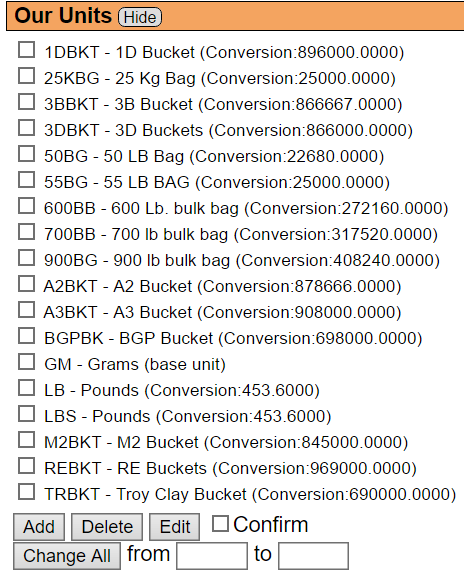Volume units are never used in ceramic glaze and body recipes (because different powders can have drastically different weights-per-volume-unit depending on the particle size and shape, settling time, moisture content, parent mineral form, etc). Typically, hobby glaze recipes do not even specify units. And they usually total 100. Most people know that making a glaze from 100 grams of powder will produce about half a cup. We control the total weight of a batch by simply retotalling it. For example, to mix a gallon (about 3000 grams) we multiply a one-hundred-total recipe by 30.

Recipes generally just have numbers that normally total 100. Potters mix batches in grams, kilograms or pounds (to make 10,000 grams, for example, just multiply the numbers by 100). But in production situatVoluions mix tickets need to be printed. These tickets often include full-bag quantities of materials (specified in the number of bags), liquid units or volumetric quantities. In this ticket, "50BG" means 50 lb bag ("LB" is pounds).

This is the same recipe in edit mode. Notice the units for each item have been filled in to the Units column (most of the time we ignore that column). These must be valid abbreviations as defined in the Units Manager. The percentage column on the right is calculated based on the weight of each unit.
The Units Manager Panel

Add, remove and edit units here. Following are the rules for how units should be set up.
- There must be a base unit with a conversion value of 1 (in the example, it is grams).
- If no units are present in the Units list, Insight-Live automatically adds a base unit (of grams).
- If some recipe lines specify a unit and others do not, then the ones without are assumed to be the base unit.
- Unit abbreviations used in recipes must match these abbreviations (they are case sensitive).
- If a line in a recipe contains a unit that cannot be found in the units list, then it will be asterisked and calculate to zero in the percentage column (thereby affecting any retotal, cost or chemistry calculations).
- The batch size of a recipe is assumed to be in the base units.
- If a recipe has an assigned batch size, recipe reports will be calculated to that total by default.
Editing Units

Use the Add button to add a unit. Check a checkbox and click Edit to change the name and abbreviation of a unit. Check a checkbox and click Delete to remove a unit (if Show Delete Confirm checkboxes is set on in your Preferences, there will also be a confirm checkbox here that has to be checked for a delete to proceed).
Changing the Abbreviation of a Unit
To change all the unit abbreviations for all the lines in all your recipes (e.g. LBS to lbs): Enter values into the from and to blanks and click the Change All button (of course, you also need to change the actual unit in this dialog so the changed lines link to it). This Change-All feature can also be employed to insert a unit abbreviation into all recipe lines that are blank: Leave the from-blank empty. To remove an abbreviation from all lines, leave the to-blank empty. Of course, you should use these features with caution! Consider testing in your account at backup.insight-live.com first.
Large or Volumetric Units

If you are working in a large scale production situation you may have custom units-of-measure. In this group account example (notice the title: "Our Units") original container bag units (e.g. 50BG) and loader bucket units (e.g. 1DBKT) have been defined, these are used on production mix tickets. The base unit is still grams (for use in the lab). These larger units, of course, have large-number gram conversion values.